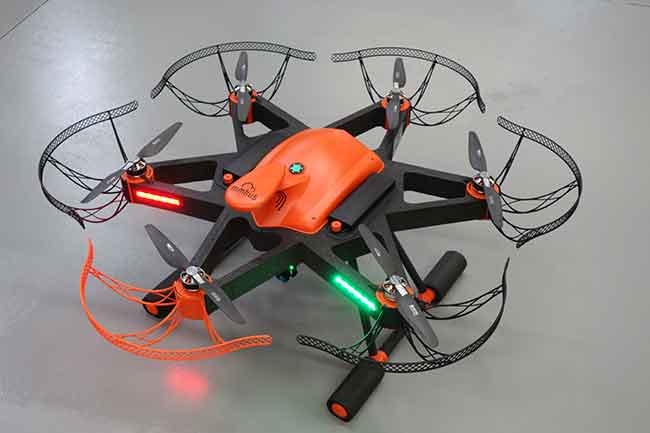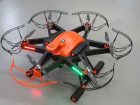
Features
In the Field
Industry
All Systems Go
November 1, 2016 By Special to UAV
 A lightweight RPAS like the Nimbus is appropriate for monitoring tasks in many practical industrial applications. PhotoS: flir
A lightweight RPAS like the Nimbus is appropriate for monitoring tasks in many practical industrial applications. PhotoS: flirAs a leading manufacturer of UAV Thermal Imaging Cameras, FLIR is setting new standards in UAV imaging technology. The Nimbus RPAS with thermal kit from INPROTEC IRT featuring FLIR Ax5-Series thermal camera was put to the test at the Department of Energy – Politecnico di Milano University in Italy. Here’s a peak at the results.
From wind turbines to industrial production plants, when cooling towers or insulated roofs are involved, UAVs or Remotely Piloted Aircraft Systems (RPAS), have proven to be a very reliable and accurate tool for faster and more complete industrial inspections and surveillance.
Nimbus S.r.l., a safety-oriented RPAS constructor, joined forces with FLIR distributor INPROTEC IRT and the SolarTech Lab of the Politecnico di Milano University to construct a professional inspection solution for industrial applications and photovoltaic power plants based on drone-mounted FLIR A35/65 cameras. Coupled with high-quality visible sensors, and controlled by a custom developed onboard PC, FLIR thermal cameras provide the drone operator with precise temperature data, thus making a complete inspection possible in a quick overflight.
Inspections From the Air
Over the past decade, the use of solar energy has expanded into a wider range of applications, including power plants, industrial applications, buildings, telecommunications and space. The use of RPA systems for monitoring energy applications has not been researched adequately yet, due to its novelty and to the many regulations. However, RPA systems have a lot of potential for monitoring photovoltaic plants, and they can even outperform traditional industrial maintenance procedures, because they are a lot cheaper and less risky.
In many cases, information collection with RPAS is more reliable and precise and 10 times faster than ground-based inspections. Italian RPAS constructor Nimbus immediately saw the added value, both from a technical and economic standpoint, of performing industrial inspections with RPAS, rather than with manned vehicles or by human operators. In an experimental set-up, Nimbus combined a lightweight RPAS with a FLIR A65, for remote inspection of a photovoltaic (PV) power plant.
Maintenance of PV plants
The presence of PV plants has grown across Europe, thanks to financial incentives. However, very often the overall quality of these plants is not as expected. The number of distributed PV plants producing electricity has increased significantly and most of the installations are now decentralized. Increased attention has been paid to the system performance of PV plants: these systems should be efficient, reliable, safe and stable in order to control and correctly predict energy flows. Maintenance of PV plants is therefore very important to ensure energy efficiency, safety, reliability, and cost-effectiveness. The new, lightweight Nimbus RPA system is an excellent tool for energy equipment monitoring, thanks to its fast detection, large area coverage, cost-effectiveness, real-time imagery and lightweight. Recent innovations in UAV technology, sensors, and control systems by the company Nimbus have made it possible to use unmanned aerial vehicles for the inspection and monitoring across different energy plants.
RPAS in Energy Applications
Generally, micro- and mini-RPAS are utilized in low-altitude and uncontrolled airspace. Typically, lightweight RPAS, with a load less than 150 kg, are appropriate for monitoring tasks in many practical industrial applications. Normally, the speed of an RPAS will vary roughly from tens to hundreds of kilometres per hour. A low-speed RPAS like the NIMBUS PPL 612 is more useful for inspection purposes. The NIMBUS PPL 612 RPAS is equipped with a thermographic kit from INPROTEC IRT and a FLIR Ax5 camera. Thanks to its architecture, designed to be safe and reliable, the PPL 612 was chosen by Politecnico di Milano University to survey PV fields and collect data for PV performance analysis.
Experimental Studies at Solar Tech Lab
The Solar Tech Laboratory, a department of the Politecnico di Milano University, focuses on experimental investigation of electrical and thermal power generation based on solar energy carrying. The research institute also undertakes experimental studies to discover a reliable and cost-efficient method to monitor the performance of PV plants by lightweight RPAS. An experimental study performed in collaboration with Nimbus was carried out across different operating plants in Italy.
The institute has used both visual and thermal sensors to detect defects or anomalies in PV modules. In a number of experiments, Nimbus and Solar Tech demonstrated that thermal cameras are a reliable, fast and cost-effective tool to detect defects like hot spots or snail trails in a fast way.
RPAS with thermal Vision
The Nimbus PPL 612 is a lightweight RPAS with six rotors and 5.3 kg Maximum Takeoff Weight (MTOW). The double avionics and redundant batteries make it reliable and safe to fly over PV plants. The system’s impressive flight stability and professional-focused flight modes give the remote pilot the possibility to control the RPAS with great precision during the flight. The system allows the RPAS operator to get the best out of the FLIR A65 camera and to obtain an accurate map of single PV cell defects.
The thermographic kit developed by INPROTEC IRT allows operators to record both the radiometric video and single radiometric images during the flight. Every recorded image is also saved with integrated GPS data. The kit is compatible with FLIR’s Ax5, A615, A655sc and similar camera models. The RPAS operator can see the video in real time from the ground and command a start and stop of the recording. Before the flight, it is possible to set all specific FLIR camera and recording parameters.
The Ax5-Series are cost-effective infrared cameras, with the FLIR A5 being the most affordable. They are ideal tools for putting thermal imaging at work in an automation, machine vision or UAV environment. All models are extremely compact.
“The FLIR Ax5-Series is an ideal camera solution for this application,” comments Luciano Betti, sales manager at INPROTEC IRT. “One of the main benefits of our application is that we can offer full radiometric video streaming from the ground in real time. Each radiometric video frame coming from the FLIR camera has integrated GPS and temperature data. The Ax5-Series allows us to collect high-resolution images much faster than is possible with competitive camera models. The FLIR cameras are rugged, lightweight, easy to install and very affordable, especially in comparison with certain portable camera models.”
Print this page
